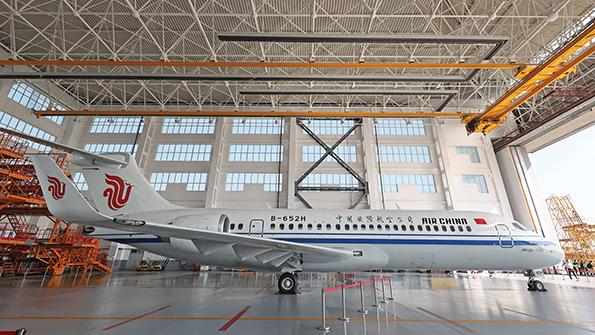
The Dongjiang Free Trade Port Zone received its 2,000th leased ARJ21 passenger aircraft on July 29, 2022.
China made a big splash when it jumped into the aircraft leasing market in the mid-2000s, starting with the Bank of China’s acquisition of Singapore Aircraft Leasing Enterprise in December 2006 for $965 million in cash. It then was renamed BOC Aviation.
Other Chinese banks soon followed suit. The Industrial and Commercial Bank of China, Minsheng Bank and the Bank of Communications all established aircraft leasing units.
- Changing political winds alter industry’s trajectory
- Chinese lessors need time to learn a new business
“It [air finance] is part of the broader scaffolding around building an aviation sector and a good hedge against inflation,” says Richard Aboulafia, managing director of consultancy Aero-Dynamic Advisory. Noting Japanese banks made a substantial impact on aircraft leasing when they entered the industry in the early 1990s, he says: “We’re seeing China exceed that.”
Katie Chen, a senior director at Fitch Ratings in Taiwan, tells Aviation Week the Chinese lessors’ link to the massive state banking ecosystem has “given them a funding benefit” that has smoothed their path into the aviation financing business.
China’s arrival in air finance was well encapsulated by the blockbuster 2016 initial public offerings of BOC Aviation, which raised $1.1 billion, and China Development Bank Leasing, which raised $799 million.
In just over a decade, the number of Chinese-funded lessors among the world’s top 50 increased from just one in 2009 to 15 in early 2021, according to China’s State Council.
That may well turn out to be China’s apex in aviation financing as economic malaise, palace intrigue and geopolitical risk weigh on an industry borne of unique political and financial conditions—which are unlikely to return. The Chinese economy grew at an average annual rate of 8.94% between 2005 and 2019 but only at 4.53% between 2020 and 2022. The mid-2010s saw Chinese companies go on high-profile shopping sprees for prime assets overseas in support of Beijing’s call to “go out.”
“Pre-COVID, China was flush with cash and saw the lucrative side of the aircraft leasing business,” says Shukor Yusof, Malaysia-based founder of the consultancy Endau Analytics. Before the pandemic, “you were looking at returns of 10-12% per annum on aircraft leasing companies.”
“The fastest way to get into the business was to buy up existing aircraft leasing companies,” he notes—as BOC did or as the HNA Group did when it bought Avolon for $7.6 billion and the Irish lessor, then as part of the HNA Group, acquired the aircraft leasing unit of U.S. financing group CIT for $10 billion.
In BOC Aviation’s case, the company has thrived since its acquisition by the Bank of China. “BOC Aviation is one of the best-run aircraft leasing companies in the world,” Yusof says. “The people at the top are very experienced and have a deep understanding of the aircraft leasing business.”
The same has not held true for HNA. Though the company helped create the world’s third-largest aircraft lessor, it came at a steep cost. The $10 billion that HNA paid through Avolon was a 6.7% premium over CIT’s adjusted net asset value. HNA already was deep in debt and probably could not have afforded to buy CIT. But HNA was determined to become a commercial aviation juggernaut as well as one of the world’s top 100 companies by the end of the 2020s.
When the deal was announced in 2016, Avolon CEO Domhnal Slattery told Bloomberg: “Our strategic objective is to build the No. 1 aircraft leasing company in the world in terms of size, shape and scale.”
The Dublin-based company has not reached that goal yet, as the AerCap fleet remains the world’s largest by several metrics.
A source with knowledge of the thinking behind China’s plunge into aviation financing tells Aviation Week that former Chinese Vice President Wang Qishan, a close confidante of the country’s leader, Xi Jinping, strongly supported a buildup of China’s aircraft leasing industry. Chen Feng, the billionaire chairman of the HNA Group, was once an aide to Wang, and the two are considered close. Xi, meanwhile, considers aviation highly strategic and has called for China to achieve greater self-sufficiency in the sector. In November 2019, at the launch of Beijing Daxing International Airport, he said: “We need to build more advanced aviation hubs.”
The apparent high-level political backing for China’s aircraft leasing deals explains why they sometimes were made even when the numbers did not seem to add up.
“Western competition said these deals make no sense; they won’t make money,” the source says. “The intention was never to make money, but to break into the market.”
One flagship project has been the Dongjiang Free Trade Port Zone (DFTP) in the northern coastal city of Tianjin, which says it is the world’s No. 2 aviation leasing hub after Ireland in terms of asset volume. In July 2022, DFTP’s 2,000th leased aircraft, a Comac ARJ21, was delivered.
It is possible Chinese lessors have helped China’s own airlines save money. The Global Times, a Chinese Communist Party-owned newspaper, reported in July 2022 that use of the bonded model by China’s aircraft lessors has saved airlines about 6% of rental costs compared to leasing from abroad, though it did not offer any data to support that assertion. The report also said: “Chinese aircraft leasing companies have provided a large amount of low-cost capital and high-quality services to the civil aviation industry.”
“The reduction in aircraft leasing costs has been transmitted to airline ticket prices, which also have reduced the cost of air travel for domestic passengers,” Shi Jinfeng, deputy director of the Financial Leasing Bureau of the DFTP, told The Global Times.
While that may be true, Wang retired from politics in March, and even before that reportedly had a diminished political influence, perhaps due to unproven allegations that he and his relatives had a financial interest in the HNA Group.
Meanwhile, the appetite for financing aircraft outside of China has waned. Chinese lessors “are becoming more conservative and cautious,” says Fitch Ratings’ Chen, adding that it is normal for growth to slow after a rapid initial period of building a leasing business.
To that end, the China Aircraft Leasing Co. (CALC) in August jettisoned its plans to take 64 Boeing 737-8s, -9s and -10s, instead transferring the order to Middle East lessor Dubai Aerospace Enterprise (DAE). Deliveries are scheduled to occur between 2023 and 2026. Terms were not disclosed.
With regard to the financial rationale for the deal, Chen points out that CALC’s business model emphasizes providing services for every stage of the aircraft life cycle, including aircraft trading. “While the trading business was very muted during the pandemic, it has heated up the industry’s post-pandemic recovery,” she says. “There is a supply shortage [of aircraft] relative to demand, which could have made this an attractive transaction to unload their orderbook.”
At the same time, selling this orderbook should improve CALC’s financial metrics as it helps to reduce the company’s leverage, she adds.
DAE said in an Aug. 15 statement that the transaction “will add certainty to our growth trajectory,” on a pro-forma basis increasing the lessor’s fleet to 550 aircraft valued at roughly $20 billion.
Persistent U.S.-China tensions may have influenced CALC’s decision to sell the Boeing aircraft to DAE, although there have been signs of a modest thaw in the bilateral relationship in recent months. Aviation Week reported in September that Boeing may resume delivery of the 737 MAX in China.
CALC and Boeing first announced the Chinese lessor’s purchase of 50 737 MAXs at the 2017 Paris Air Show. At the time, Wang Qishan was still a member of the Chinese Communist Party’s Politburo Standing Committee, China’s paramount political advisory body made up of its seven top leaders. Chinese lessors were building up their fleets aggressively, and the U.S. and China had yet to enter open great-power competition.
In an Aug. 22 announcement, CALC said it has “actively participated in facilitating the commercial operation of China-made aircraft,” including the first delivery of a Comac ARJ21 outside of China—to Indonesia’s TransNusa Airlines, a subsidiary of the Chinese lessor. Overall, CALC’s backlog includes 28 Comac aircraft.
“CALC’s commercial dealings hinge as much on the close relationships between its top executives and some airline customers as its ability to provide—in the case of Indonesia’s TransNusa—technical incentives for the China-made jets,” Yusof says.
Yusof expects Chinese lessors with strong international management teams such as BOC Aviation will continue to succeed—even in tougher economic and geopolitical conditions. However, there could be hard lessons for lessors that continue to run their businesses on wobbly foundations.
“The Chinese are new to aircraft leasing,” Yusof says. “This is a business that has been controlled by the Europeans and Americans for the last half-century. It’s not something that you can learn overnight.”





